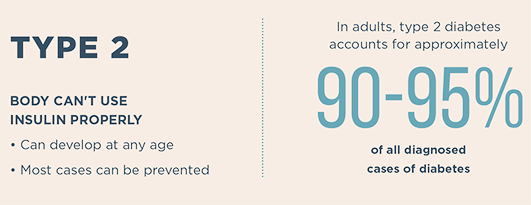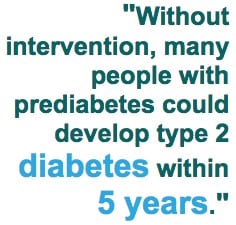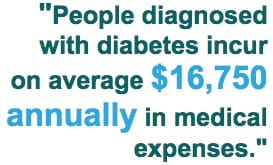Presented By Hometown-Motors, Inc.
If you’re interested in participating in a CDC-recognized lifestyle change program, learn more about the benefits of joining. You’ll get a full year of support and learn how to eat healthy, add physical activity to your routine, manage stress, stay motivated, and solve problems that can get in the way of your goals. This program is proven to prevent or delay type 2 diabetes. Participants who lost 5-7% of their body weight and added 150 minutes of exercise per week cut their risk of developing type 2 diabetes by up to 58% (71% for people over 60 years old).
Find out if you might be eligible to participate, see testimonials from past participants, and find an in-person or online program today!
Over 88 million American adults have prediabetes – that’s 1 in 3 adults! Of those 88 million, more than 8 in 10 of them don’t even know they have it. Without taking action, many people with prediabetes could develop type 2 diabetes within 5 years.
With numbers like that, it’s important to learn about prediabetes and take action.
Having prediabetes means your blood glucose (sugar) levels are higher than normal—but not high enough to be diagnosed as diabetes. Prediabetes can lead to heart disease, stroke, and type 2 diabetes, the most common form of diabetes. Prediabetes can often be reversed.

With type 2 diabetes, your body cannot properly use insulin (a hormone that helps glucose get into the cells of the body). You can get type 2 diabetes at any age, but you are at higher risk if you are older, overweight, have a family history of diabetes, are not physically active, or are a woman who had gestational diabetes.
Gestational diabetes is a kind of diabetes that some women get when they are pregnant. Even if a woman’s blood sugar levels go down after her baby is born, she is at higher risk of getting type 2 diabetes later in life.
With type 1 diabetes, your body cannot make insulin, so you need to take insulin every day. Type 1 diabetes is less common than type 2; approximately 5-10% of the people who have diabetes have type 1. Currently, no one knows how to prevent type 1 diabetes.
Who is at Risk for Prediabetes and Type 2 Diabetes?
If you have these risk factors, you may be at higher risk than others for prediabetes and type 2 diabetes.
- You are overweight.
- You are 45 years of age or older.
- Your parent or sibling has type 2 diabetes.
- You are physically active fewer than 3 times per week.
- You ever gave birth to a baby that weighed more than 9 pounds.
- You ever had diabetes while pregnant (gestational diabetes).

Race and ethnicity also affect your risk. African Americans, Hispanic/Latino Americans, American Indians, Pacific Islanders, and some Asian Americans are at particularly high risk for type 2 diabetes.
Following are the percentage of people in the United States with diagnosed diabetes from 2010 to 2012 among people aged 20 or older, by race and ethnicity:
- American Indian/Alaska Natives – 15.9%
- Non-Hispanic blacks – 13.2%
- Hispanics – 12.8%
- Asian Americans – 9.0%
- Non-Hispanic whites – 7.6%
If you are at risk, talk to a health care professional about getting a blood sugar test.
Diabetes Has Serious Consequences
Diabetes Is Serious and Common

Diabetes is currently the seventh leading cause of death in the United States—and studies show that deaths related to diabetes may be under-reported! Today, 1 in 10 U.S. adults has diabetes, and if trends continue, 1 in 5 will have it by 2025.
An additional 88 million U.S. adults – 1 in 3 – have prediabetes, which means their blood sugar is higher than normal, but not high enough to be considered type 2 diabetes. Without intervention, many people with prediabetes could develop type 2 diabetes within 5 years, which puts them at risk of serious health problems, including:
- Heart attack
- Stroke
- Blindness
- Kidney failure
- Loss of toes, feet, or legs
Diabetes Is Costly

Type 2 diabetes affects millions of individuals and their families, workplaces, and the U.S. health care system. In 2017, the total cost of care for people with diagnosed diabetes was $327 billion, up 33% over a 5-year period. About 1 in 4 health care dollars is spent on people with diagnosed diabetes. The majority of expenses are related to hospitalizations and medications used to treat complications of diabetes.
People diagnosed with diabetes incur on average $16,750 annually in medical expenses. That’s about 2.3 times the medical expenses of a person without diabetes. The need to prevent type 2 diabetes has never been greater.
You Can Prevent Type 2 Diabetes—Get Started Today!
If you have prediabetes, a CDC-recognized lifestyle change program is one of the most effective ways to prevent getting type 2 diabetes. It can help you lose weight, become more active, and prevent or delay type 2 diabetes. To learn more, visit Why Participate?
If you’re not sure if you’re at risk, take this online test or ask your health care professional about getting a blood sugar test.



More Stories
Waverly Students Win FBP Diversity Council Art Contest
Longtime SPVMHC Board Member Honored As Rulon Center Celebrates 5th Anniversary
Local Man Appointed Ohio Volunteer Service Coordinator